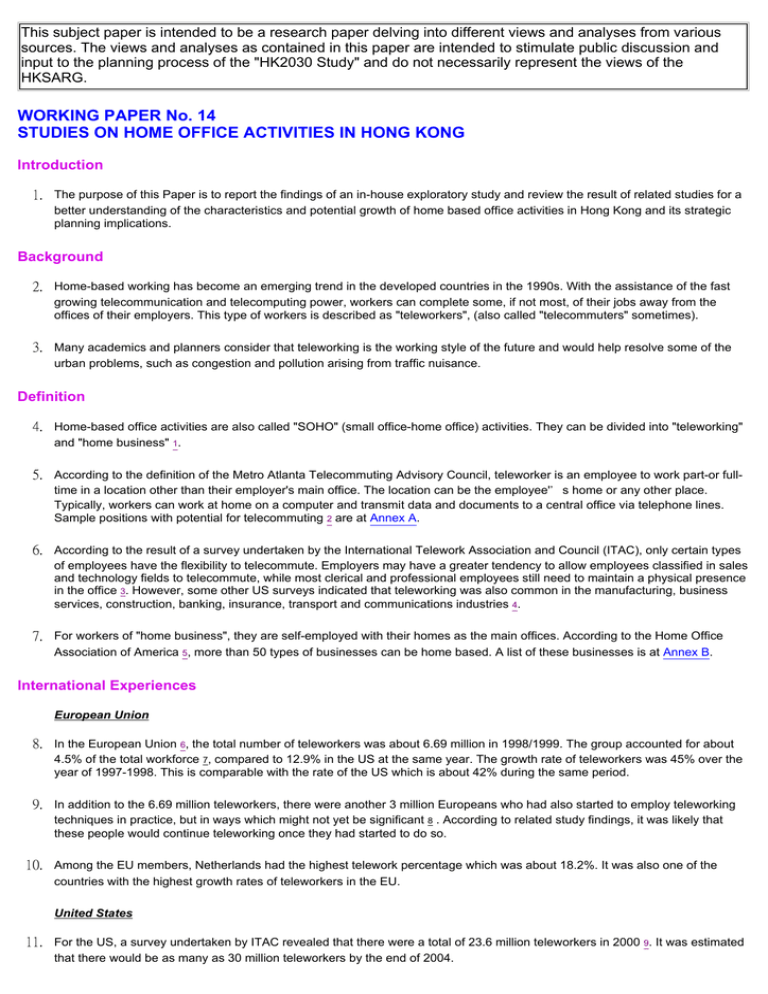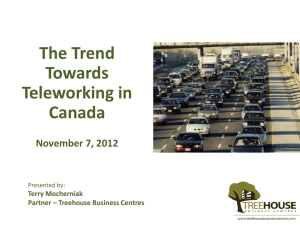Studies on Home Office Activities in Hong Kong Review of U.S. and
advertisement

This subject paper is intended to be a research paper delving into different views and analyses from various sources. The views and analyses as contained in this paper are intended to stimulate public discussion and input to the planning process of the "HK2030 Study" and do not necessarily represent the views of the HKSARG. WORKING PAPER No. 14 STUDIES ON HOME OFFICE ACTIVITIES IN HONG KONG Introduction 1. The purpose of this Paper is to report the findings of an in-house exploratory study and review the result of related studies for a better understanding of the characteristics and potential growth of home based office activities in Hong Kong and its strategic planning implications. Background 2. Home-based working has become an emerging trend in the developed countries in the 1990s. With the assistance of the fast growing telecommunication and telecomputing power, workers can complete some, if not most, of their jobs away from the offices of their employers. This type of workers is described as "teleworkers", (also called "telecommuters" sometimes). 3. Many academics and planners consider that teleworking is the working style of the future and would help resolve some of the urban problems, such as congestion and pollution arising from traffic nuisance. Definition 4. Home-based office activities are also called "SOHO" (small office-home office) activities. They can be divided into "teleworking" and "home business" 1. 5. According to the definition of the Metro Atlanta Telecommuting Advisory Council, teleworker is an employee to work part-or fulltime in a location other than their employer's main office. The location can be the employee'’s home or any other place. Typically, workers can work at home on a computer and transmit data and documents to a central office via telephone lines. Sample positions with potential for telecommuting 2 are at Annex A. 6. According to the result of a survey undertaken by the International Telework Association and Council (ITAC), only certain types of employees have the flexibility to telecommute. Employers may have a greater tendency to allow employees classified in sales and technology fields to telecommute, while most clerical and professional employees still need to maintain a physical presence in the office 3. However, some other US surveys indicated that teleworking was also common in the manufacturing, business services, construction, banking, insurance, transport and communications industries 4. 7. For workers of "home business", they are self-employed with their homes as the main offices. According to the Home Office Association of America 5, more than 50 types of businesses can be home based. A list of these businesses is at Annex B. International Experiences European Union 8. In the European Union 6, the total number of teleworkers was about 6.69 million in 1998/1999. The group accounted for about 4.5% of the total workforce 7, compared to 12.9% in the US at the same year. The growth rate of teleworkers was 45% over the year of 1997-1998. This is comparable with the rate of the US which is about 42% during the same period. 9. In addition to the 6.69 million teleworkers, there were another 3 million Europeans who had also started to employ teleworking techniques in practice, but in ways which might not yet be significant 8 . According to related study findings, it was likely that these people would continue teleworking once they had started to do so. 10. Among the EU members, Netherlands had the highest telework percentage which was about 18.2%. It was also one of the countries with the highest growth rates of teleworkers in the EU. United States 11. For the US, a survey undertaken by ITAC revealed that there were a total of 23.6 million teleworkers in 2000 9. It was estimated that there would be as many as 30 million teleworkers by the end of 2004. 12. According to the ITAC survey, 89% of the interviewed teleworkers were solely home-based. 7% were solely based on telecenters 10 which were designed to facilitate teleworking by providing work-stations, equipment and office-like environments in outlying locations, proximal to employees homes. The rest of the interviewed teleworkers (4%) are both home- and telecenter-based. 13. Contrary to the general perception, half of the teleworkers worked for organizations with at least 1,500 employees. 14. The ITAC survey showed that, on average, teleworkers worked remotely about 20 hours per week. They spent 38% of their work time at their computers, 17% on the phone, 24% reading, research and analysis, 9% in face-to-face meetings and 12% on other matters. 15. It was also found that home-based teleworkers had larger homes, on average, than non-teleworkers; the difference amounting to about 500 square feet. The most popular place for an office in these larger homes was a spare bedroom, with the living room closeby. 16. As revealed in the ITAC survey, only 62% of the employee-teleworkers reported that their direct supervisors worked in the same cities or towns. In 19% of the cases the supervisors were not even in the same states as the teleworkers. Policy Implications 17. As pointed out by ITAC and other professionals 11, the growth of home based office activities may result in a more decentralised urban form, i.e. exacerbating the urban sprawl. Nevertheless, the growth can effectively reduce commuter trips and hence improve the environment 12. 18. In this regard, advocates of teleworking demand government's recognition of its importance and assistance to teleworkers, which is mainly fiscal in nature (e.g. tax allowance, grants, etc.). The other proposals include administrative measures, such as restructuring of the public administration to allow for teleworking and review of covenants and local zoning regulations to avoid unreasonably prohibiting teleworking from home offices 13. Previous Studies undertaken by Planning Department 19. According to the findings of studies recently undertaken by Planning Department (PlanD), it was found that teleworking was uncommon in Hong Kong at that time. 20. PlanD has studied the potential impact of teleworking on the trend of office decentralisation in the late 1990’s. A survey was undertaken under the Study on the Propensity for Office Decentralisation and the Formulation of an Office Land Development Strategy (OLDS) in 1996/1997. According to the survey, less than 10% of the interviewed establishments indicated their interests in introducing or increasing teleworking in the establishments. 21. In addition, the study also found that, although businesses in Hong Kong would tend to use more advanced technology in future, making face-to-face contacts was more important than the use of telecommunications technology in Hong Kong's tradition of doing business. 22. Another related study is the Second Survey to Ascertain the Parameters for Forecasting Employment Distribution (SAPFED II) which was completed in late 2000. Although the study was undertaken mainly to investigate the working density and other related characteristics of non-domestic units, the survey has also covered the practice of telecommuting. By visiting about 100,000 ratable non-domestic units, it was found that only about 0.3% of the employees were working at home. Among various industries, business services and retailing have relatively high percentage shares of employees working at home in their own employment totals. The percentages are 0.8% and 0.7% respectively. 23. Notwithstanding the low percentages, it is likely that the survey has under-estimated the popularity of teleworking in Hong Kong due to the following reasons: a. The survey did not cover domestic units. The number of home-businesses is thus unknown . b. The definition of teleworking may be too stringent as teleworking should also include employees working at home for only a few days in a month, e.g. less than a week, and "road warriors", i.e. employees who typically operate from virtual offices such as sales executives or field service technical support engineers 14. 24. Moreover, the long-term share of teleworking in the total employment is still early to say. In developed economies, the share can increase substantially within a relatively short period of time. For example, in the US, the share has increased from 2.9% in 1990 to 14.7% in 1999 15. The annual growth rate is about 20% on average. In this regard, the coming Census in 2001 will collect and examine information concerning work at home in greater details. This will facilitate a further examination of the trend of home-office activities. Findings of an Exploratory Case Study 25. To enhance the understanding of teleworking, the HK2030 Study has carried out case studies on workers related to home businesses and IT development from May 2000 to August 2000. A total of 8 interviews have been conducted. The interviewees were identified through the internet, mass media and seminars. They work in the fields of internet, computer hardware and programming, surveying, architecture, academic and business centre. 26. The major findings are as follows: a. Many of the interviewees were optimistic about the prospect of teleworking as they thought that workers would increasingly prefer flexible working environment. In addition, after the financial turmoil in 1997, out-sourcing had become a trend for businesses in Hong Kong. This provides home business with a favourable business environment. b. Some interviewees only considered home business as the stepping stone to the conventional business operation c. d. e. f. g. h. i. j. because of its low start-up cost. The mode of home businesses is particularly suitable for professionals, artists, translators, designers and IT workers. Regarding policy support to teleworking, the interviewees were mainly concerned with IT infrastructure and financing. However, some interviewers also expressed their interest in the concept of "SOHO building"or "SOHO park". Contrary to the general perception, home business workers still had to travel quite frequently to urban areas for meetings, seminars or other businesses. The accessibility of their home offices remained to be a concern of these workers. In addition, it was easier for interviewees to obtain supporting services, such as computer repairing, in the core urban areas. Therefore, quite similar to commuters, the interviewed home business workers preferred living in the core urban areas or places close to transport nodes. It would be very useful if home business workers could have their own reading/working rooms in their apartments. Living space thus could be a concern. Teleworking provided an alternative option for female workers who needed to take care of their children and families. For individual home businesses, the chance of success appeared to be better if teleworkers were experienced in their profession. It would be easier for these workers to market themselves and solicit jobs. In view of the low overhead and flexible working style, home businesses could allow retired persons to extend their careers. Some interviewees indicated that clients generally might not have confidence in home businesses. Business centres might be useful in providing home businesses with more conventional correspondence addresses and places for meetings. Study on IT Industries 27. A focused study on the adoption of telecommuting in the IT industries in Hong Kong was carried out by Professor Louis Leung of the Chinese University of Hong Kong in 2000. In the study, Professor Leung undertook a survey of 243 employers and 380 employees randomly selected from the Hong Kong IT Directory (1999) and the Directory of Hong Kong Information Services Industries (1999-2000). Of these 623 respondents, less than 3% were telecommuters, only 4.9% of the employers and 1.3% of the employees telecommute. However, among those non-telecommuters, 37% of the employers and 20% of the employees expressed interest in telecommuting. When jobs require more innovation, employees were more willing to adopt telecommuting. 28. The study found that, for employers, relative advantages and observable benefits were not important motivations for telecommuting adoption decision. In addition, constraints on the growth of home based office activities were mainly social, psychological and organisational, rather than technical in nature. Examples include: a. incompatibility with the current practice. The study revealed the employer's perception that teleworking would be b. c. frustrating for the organisation because it did not allow the benefit of face-to-face interaction, Teleworking would be difficult as certain jobs might need significant amount of coordination and group discussions, and troublesome as it relied more on good planning and task allocation. Some employers also felt that it would be difficult for managers to monitor subordinates from a distance. For the employees, there was concern that teleworking would make employees feel alienated and isolated, and would miss the conversation at the office; institutional constraints. It was found that workers' compensation claims were difficult to be determined when employees are working at home, where they are surrounded by non-work-related distractions and responsibilities; and failure to relate the quality of life and teleworking. This may be because teleworking could bring more responsibilities and works instead of improving quality of life. Strategic Planning Implications 29. Based on the researches mentioned above, whether teleworking will become a significant component of the employment in Hong Kong is too early to conclude at this stage. Nevertheless, as evident in the US example mentioned in para. 24, it is possible that the share of teleworkers in the employment in Hong Kong will increase significantly in the next 5 to 10 years. In particular, according to Professor Leung’s study, employers and employees in the IT industries are more willing to adopt teleworking. While IT will likely become an essential component in many other industries, it will facilitate the adoption of teleworking in these industries. 30. In this regard, if teleworking becomes popular, the following potential strategic planning implications should be noted: a. The commuter trips may be reduced even though most of the commuters in Hong Kong take mass transit. This may help alleviate the traffic congestion and related air and noise problems. b. The urban form may tend to be less centralized as the need for housing close to the central business district would c. d. e. be less acute. Nevertheless, the housing will still have to be located close to transport nodes, especially in the context of Hong Kong where car ownership is exceptionally low. The growth of office demand may be slowed down as residential units become a substitute to office floorspace. The housing demand may change accordingly. For example, there may be a stronger demand for large flats as teleworkers need additional workspace at home. On the other hand, it may also induce demand for small flats as some young teleworkers may move out from their parents' homes for their own spaces. There may be a greater demand for commercial and community services in residential neighbourhoods during daytime. However, this may not necessarily imply a greater demand for commercial and community spaces as teleworking may only mean a better utilisation of such facilities. 31. In view of the potential benefits of teleworking to the traffic and environment, it may be desirable to encourage such practice in Hong Kong. In this regard, the international experience indicated that the best way to facilitate teleworking is to provide fiscal incentive or introduce the practice inside the government. However, for Hong Kong, the first step may be to carry out more researches to investigate the benefits of teleworking to the individual, business and also community in the local context. If significant potential benefits are identified, consideration may be given to education and promotion of such benefits to the public, together with administrative and management suggestions for adoption of teleworking. 32. As noted in the case study for the HK2030 Study, some interviewees are interested in the concept of "SOHO building". In fact, some developers have already marketed their service apartments in the city core as "SOHO buildings" 16. In this regard, there are calls for review of government policies to encourage teleworking, such as creating a new type of development that allows both office and domestic uses at the same place. 33. However, it should be noted that, under the current planning system, home-based office activities in residential premises, depending on their nature and scale, are not discouraged provided that the predominant residential nature of the premises remains unchanged. Way Forward 34. Based on the findings of literature review and various studies, it is evident that teleworking is not popular in Hong Kong. As there are little statistical data on such working mode, it is difficult to estimate its prospect. In this regard, further studies on the subject, including its benefits in the context of Hong Kong, would be necessary. 35. Currently, the major bottleneck of the growth of teleworking appears to be social, organisational and institutional, rather than technological. It is noted that these issues may become less significant as the new generation is more used to the information technology. Nevertheless, if it is intended to promote teleworking in Hong Kong, studies to tackle the identified issues would still be necessary. 36. For the HK2030 Study, it is recommended:a. To observe the growth of home-based economic activities and take it into consideration in assessing the office demand and traffic and environmental conditions; and b. In preparing economic scenarios for the Study, to include the growth of teleworking or home-based activities as part of the development of a knowledge-based economy in Hong Kong. Footnotes 1 Some analysts, such as European Telework Online, tend to confine the definition of SOHO to home business. 2 Metro Atlanta Telecommuting Advisory Council (2000). 3 Metro Atlanta Telecommuting Advisory Council (2000). 4 Example: a survey carried out by the International Telework Association and Council (ITAC) in 2000. (Source: ITAC [2000a]) 5 Home Office Association of America (2000). 6 Including Austria, Belgium, Luxemburg, Demark, Finland, France, Germany, Greece, Ireland, Italy, Netherlands, Portugal, Spain, Sweden and UK. 7 Table 2, " Status Report on European Telework: New Method of Work 1999" downloaded from the website of European Telework Online. 8 Page 25, " Status Report on European Telework: New Method of Work 1999" downloaded from the website of European Telework Online. 9 ITAC (2000a). 10 For details of telecenters, please refer to the Working Group Meeting Paper on the Implications of Implications of Information Technology on Strategic Planning. 11 Example: Pamela Blais (1999). 12 European Telework Online (2000b). 13 ITAC (2000b). 14 15 Metro Atlanta Telecommuting Advisory Council (2000). Derived from June Langhoff's Telecommuting Resource Center (2000) and US Department of Labor (2000). 16 Apply Daily (2000). ATTACHMENTS Annex A : Sample Positions with Potential for Telecommuting Annex B : Possible Home Businesses References: 1. "香港SOHO有得搞,只待政府配合" in Apply Daily of 27.11.2000, (www.appledaily.com). 2. Europe Telework Online, "Status Report on European Telework: New Methods of Work 1999" (2000) downloaded from the web3. 4. 5. 6. 7. 8. 9. 10. 11. 12. 13. 14. 15. 16. 17. 18. 19. site of the European Telework Online (www.eto.org.uk/faq/faq-numb.htm) as at 23.11.2000. European Telework Online, "Can Telework Reduce Traffic Congestion?" (www.eto.org.uk/faq/faqtpt1.htm) as at 23.11.2000. European Telework Online, "How many teleworkers?" (www.eto.org.uk/faq/faq-numb.htm) as at 23.11.2000. Home Office Association of America, "50+ Great Start-up Ideas" (www.hoaa.com/startups.htm) as at 23.11.2000. International Telework Association and Council, "Telework America 2000: Research Results- Key Findings" (http://www.telecommute.org/twa2000/research_results_key.shtml) as at 23.11.2000. International Telework Association and Council, "Telework Enabling Government Action" (http://www.telecommute.org/policy/government_action.shtml) as at 23.11.2000. Langhoff's Telecommuting Resource Center, "FAQs about telecommuting..." (www.langhoff.com/faqs.html) as at 4.12.2000. Leung, Louis, "Societal, Organizational, and Individual Perceptual Factors Influencing the Adoption of Telecommuting in Hong Kong" presented at the International Communication Conference in Communication Frontier in the New Millennium, 24-26 June 2000. Metro Atlanta Telecommuting Advisory Council (http://www.matac.org and http://www.matac.org/whatisit.htm) as at 23.11.2000. Mokhtarian, Patricia Lyon, "Defining Telecommuting", Institute of Transportation Studies, University of California, Davis, 5/1991. Pamela Blais, "Planning the Digital City" in Plan Canada, November 1999. Planning Department, HKSAR Government, "Second Survey to Ascertain the Parameters for Forecasting Employment Distribution: Tabulation-1 : General Sample (Q.1-Q.10a)", 9/2000. Planning Department, HKSAR Government, "Study on the Propensity for Office Decentralisation and the Formulation of an Office Land Development Strategy: Working Paper 3-Surveys and Consultations", 2.5.1997. Planning Department, HKSAR Government, "Survey on the Propersity for Office Decentralisation-Survey of Push and Pull Factors-Computer Tabulation", 4/1997. Planning Department, HKSAR Government, "Survey on the Propersity for Office Decentralisation- Survey of Movers-Computer Tabulation", 4/1997. Statistics and Census Department, HKSAR Government, "1999-based Employment Projections: Results of the 'Controlled' Employment Projections in Comparison with the results of 'Uncontrolled' Employment Projections", 2000. US Department of Labor, website (http://146.142.4.24/cgi-bin/surveymost) as at 5.12.2000. US General Services Administration, website (hydra.gsa.gov/pbs/owi) as at 29.11.2000. PLANNING DEPARTMENT JANUARY 2002 ANNEX A : SAMPLE POSITIONS WITH POTENTIAL FOR TELECOMMUTING Accountant Advertising Manager/Creative Staff Applications Programmer Architect Attorney Auditor Bookkeeper CAD/CAM Engineer Civil Engineer Clerk Typist Collections Manager/Staff Community Relations Liaison Copywriter Data Entry Clerk Design Engineer Economist Environmental Manager/Staff Executive Financial Analyst Graphic Artist Human Resources Manager Industrial Engineer Information Services Manager/Staff Insurance Broker Journalist/Newsletter Editor Labour Relations Manager/Staff Product Manager Project Manager Public Relations Liaison Purchasing Manager/Staff Quality Manger/Staff Research Manager/Staff Sales Person/Support Staff Sales Manager Software Engineer Statistician Strategic Planning Manager/Staff Systems Programmer Technical Writer Telemarketer Telephone Operator Source : The website of the Metro Atlanta Telecommuting Advisory Council as at 23.11.2000 ANNEX B : POSSIBLE HOME BUSINESSES Abstracting Household Referral Services Antique Locator Household Management Bed & Breakfast Information Gatherer Bookkeeping Medical Billing Business Brokerage Medical Claims Career Counselor Medical Transcriptionist Caterer Meeting Planner Child Care Provider Mobile Disc Jockey Cleaning Services, Residential News Clipping Service Collections Overcharge Collection Service College Scholarship Consultant Pager Rentals & Sales Computer Instruction Party Planner Copywriter Personal Image Consultant Database Designer Personal Shopper Delivery Service Pet Sitting Deposition Digester Plant Caregiver Fitness Instructor Public Relations Specialist Fund Raising Rare Book Broker Garage Sale Promotion Recording Secretary Gift Basket Service Relocation Consultant Graphic Designer Resume Service Greeting Reminder Seminar Producer Grocery Service Specialized Temporary Agency Headhunter Specialty Foods Herb Gardening Standardized Test Coaching Home Restoration Technical Writer Source : The website of the Home Office Association of America as at 23.11.2000.



